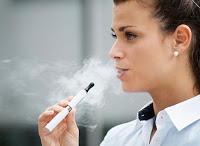Study finds 2 new probable carcinogens in e-cigarette vapor; study author says there is no such thing as a healthy e-cigarette

 |
|
ConsumerReports.org
|
“Advocates of e-cigarettes say emissions are much lower than from conventional cigarettes, so you’re better off using e-cigarettes,” researcher Hugo Destaillats said in a news release. “I would say: Regular cigarettes are super unhealthy. E-cigarettes are just unhealthy.”
The researchers, from Lawrence Berkeley National Laboratory in California, looked at the effects that temperature and the type and age of a vaping device have on e-cigarette emissions. They found that the thermal decomposition of propylene glycol and glycerin, two solvents found in most e-cigarettes, leads to the release of toxic chemicals such as acrolein and formaldehyde.
The study also found “significant levels of 31 harmful chemical compounds, including two that had never been previously found in e-cigarette vapor—propylene oxide and glycidol, both of which are probable carcinogens,” says the release.
The study, published in Environmental Science and Technology, simulated vaping by using three types of e-liquids in two different vaporizers, one cheaper version with one heating coil and the other more expensive with two parallel heating coils. They were operated at different battery power settings.
The study also looked at the difference in puffs as the device heated up and found that the first and last puffs produced “widely varying emissions,” depending on the device, the battery voltage and the emitted compound. For example, in later puffs there was much more acrolein, which is a severe eye and respiratory irritant.
The study also found that the emissions of acrolein, formaldehyde ans acetaldehyde, all either carcinogens or respiratory irritants, increased with usage on older devices that were used over nine consecutive 50-puff cycles and not cleaned.
“In some cases we saw aldehyde levels increase 60 percent between cycles 1 and 9,” study author Mohamad Sleiman said in the release.
Researchers also found that as voltage increased, so did the temperature and the amount of e-liquid consumed per puff. “The higher the temperature, the more emissions,” Destaillats said. But he also said, “We found there are emissions of toxic chemicals at any temperature at which you use the device.”
This research comes on the heels of the U.S. Food and Drug Administration’s regulation that bans the selling of e-cigarettes to minors, effective Monday, Aug. 8. Kentucky enacted such a law in 2014. According to the federal Centers for Disease Control and Prevention, teenagers are more likely to use e-cigarettes than tobacco products.